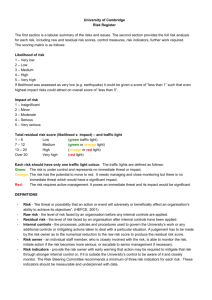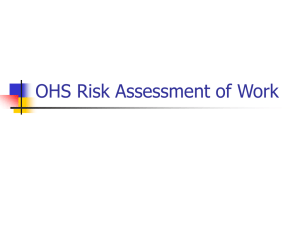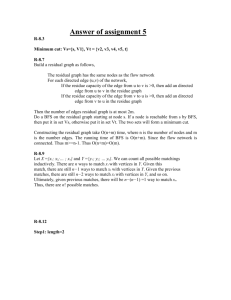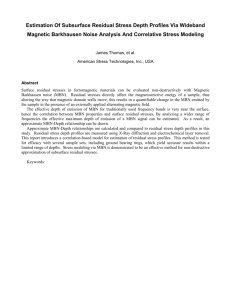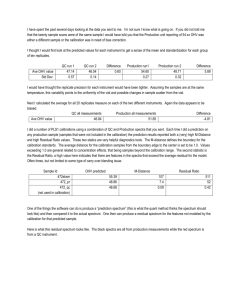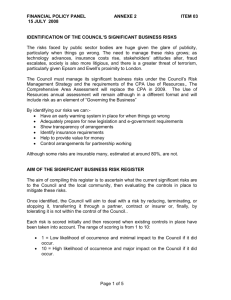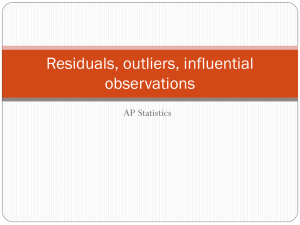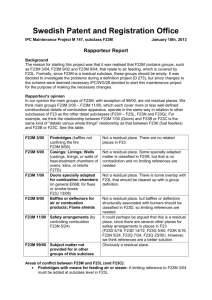Statistical Inference:
advertisement
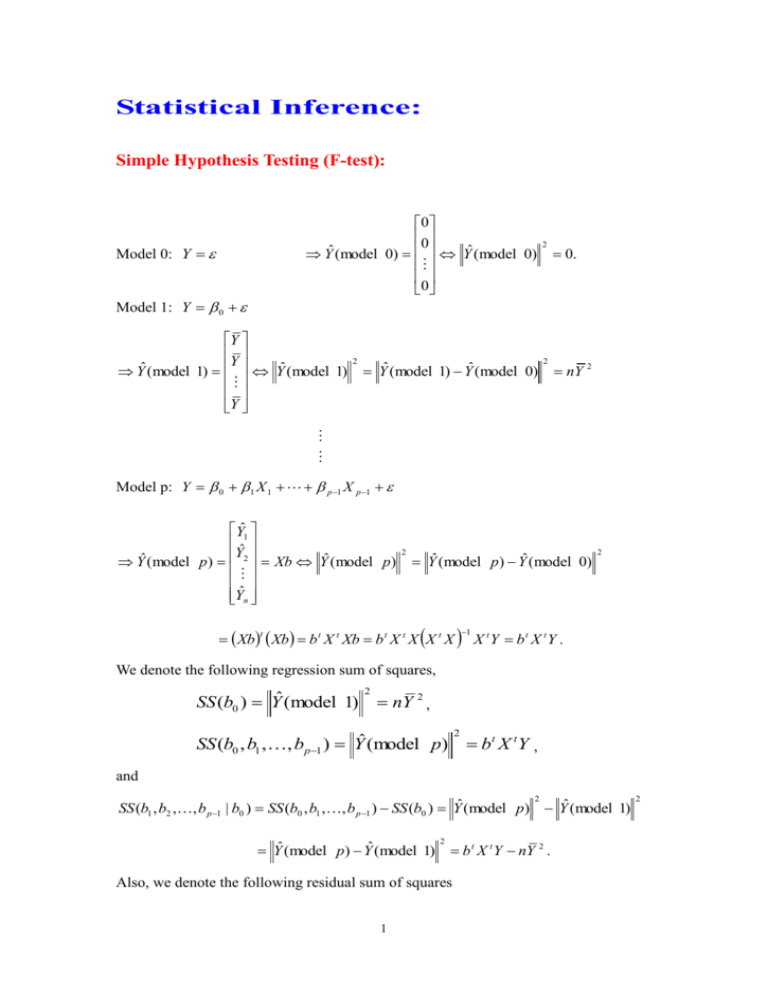
Statistical Inference: Simple Hypothesis Testing (F-test): 0 0 Yˆ (model 0) Yˆ (model 0) 0 Model 0: Y Model 1: Y 0 Y Y ˆ Y (model 1) Yˆ (model 1) Y 2 Yˆ (model 1) Yˆ (model 0) 2 0. 2 nY 2 Model p: Y 0 1 X 1 p 1 X p 1 Yˆ1 ˆ Y Yˆ (model p ) 2 Xb Yˆ (model p ) ˆ Yn 2 Yˆ (model p ) Yˆ (model 0) Xb Xb b t X t Xb b t X t X X t X t 1 2 X tY bt X tY . We denote the following regression sum of squares, SS (b0 ) Yˆ (model 1) 2 nY 2 , 2 SS (b0 , b1 , , bp1 ) Yˆ (model p) bt X t Y , and 2 SS (b1 , b2 ,, b p 1 | b0 ) SS (b0 , b1 ,, b p 1 ) SS (b0 ) Yˆ (model p) Yˆ (model 1) Yˆ (model p) Yˆ (model 1) 2 b t X t Y nY 2 . Also, we denote the following residual sum of squares 1 2 RSS (model p) Y Yˆ (model p) 2 Y Xb 2 Y Xb Y Xb t Y t b t X t Y Xb Y t Y 2b t X t Y b t X t Xb Y t Y 2b t X t Y b t X t X X t X Y 2 1 X t Y Y t Y 2b t X t Y b t X t Y Y t Y b t X t Y 2 Yˆ (m o d epl) Yˆi 0 Y (model 0) (model 1) SS (b0 ) Yi (model p) (data) SS (b1 , , b p1 | b0 ) R S S(m o d epl) n Y 2 i i 1 We have the following fundamental equation: Fundamental Equation: n Y Yˆ (model 0) Yi 2 2 i 1 2 2 Y Yˆ (model p) Yˆ (model p) Yˆ (model 1) Yˆ (model 1) Yˆ (model 0) 2 RSS (model p) SS (b1 ,, b p 1 | b0 ) SS (b0 ) (the distance between the data and model 0) = (the distance between the data and model p) + (the distance between model p and model 1) + (the distance between model 1 and model 0) The anova table associated with the fundamental equation is Source RSS (model p) SS (b0 , b1 ,b p 1 ) Total df SS n-p Y Y b X Y SS (b0 ) 1 nY SS (b1 ,, bP1 | b0 ) p-1 b t X t Y nY 2 n Y t t 2 MS MS (residual p ) 2 n Yi 2 i 1 2 t MS (b0 ,, b p 1 ) Note: RSS (mod el. p) Y t Y b t X t Y MS (residual . p) n p n p MS (b0 , b1 ,, bp1 ) SS (b0 , b1 ,, bp1 ) p bt X tY p , , and MS (b1 , , bp1 | b0 ) SS (b1 , , bp1 | b0 ) p 1 bt X tY nY 2 p 1 Simple Hypothesis Testing: (i) H 0 : 0 1 p 1 0 To test the above hypothesis, the following F statistic can be used, bt X tY MS (b0 , b1 , , bp1 ) p F t Y Y bt X tY MS (residual p) n p Intuitively, MS (b0 ,, b p 1 ) measures the difference between model p and model 0 while MS (residual p ) is the estimate of the variance 2 of the random error. Thus, large F value implies the difference between model p and model 0 is large as the random variation reflected by the mean residual sum of square MS (residual p ) is taken into account. That is, at least some of 0 , 1 ,, p 1 are so significant such that the difference between model p and model 0 (no parameter) is apparent. Therefore, the F value can provide important information about if H 0 : 0 1 p 1 0 . Next question is to ask how large value of F can be considered to be large? By the distribution theory and the 3 assumptions about the random errors i , F ~ F p ,n p as H 0 : 0 1 p 1 0 3 is true, where F p ,n p is the F distribution with degrees of freedom p and n-p, respectively. (ii) H 0 : 1 2 p 1 0 To test the above hypothesis, the following F statistic can be used, b X Y nY t F MS (b1 , b2 , , b p1 | b0 ) MS (residual p) t 2 p 1 Y Y bt X tY n p t Large F value implies the difference between model p and model 1 is large as the random variation reflected by the mean residual sum of square MS (residual p ) is taken into account. That is, at least some of 1 , 2 ,, p 1 are so significant such that the difference between model p and model 1 (only one parameter 0 ) is apparent. F ~ F p 1,n p as H 0 : 1 2 p 1 0 is true, where F p 1,n p is the F distribution with degrees of freedom p-1 and n-p, respectively. Testing for Several Parameters Being 0: H 0 : q q 1 p 1 0 To test the above hypothesis, we need to derive some basic quantities for model q (q<p), model q: Y 0 1 X 1 q 1 X q 1 . Let 1 X 11 1 X 21 X 1 X n1 X 1q 1 X 2 q 1 . Then, the least square estimate for model q is X nq1 b0* * b1 * t * 1 * t b (( X ) X ) ( X ) Y * . bq 1 4 Then, the fitted value for model q Yˆ (model q) X *b* and the distance between model q and model 0 is 2 SS (b0 , b1 , , bq1 ) Yˆ (model q) Yˆ (model 0) (b* )t ( X * )t Y . Thus, the distance between model p and model q is Yˆ ( model p ) Yˆ (model q ) 2 Yˆ ( model p ) 0 Yˆ (model q ) 0 Yˆ (model p ) 0 2 2 2 Yˆ (model q ) 0 SS (b0 , b1 ,, b p 1 ) SS (b0 , b1 , , bq 1 ) b t X t Y (b ) t ( X ) t Y SS (bq , bq 1 ,, b p 1 | b0 , b1 , , bq 1 ) Also, Yˆ ( model p ) Yˆ ( model q ) 2 Y Yˆ ( model q ) Y Yˆ ( model p ) Y Yˆ ( model q ) 2 Y Yˆ ( model p ) RSS ( model q ) RSS ( model p ) (Y t Y (b ) t ( X ) t Y ) Y t Y b t X t Y b t X t Y (b ) t ( X ) t Y To test the above hypothesis, the following F statistic can be used, 5 2 2 b X Y (b ) ( X t F MS (bq , bq1 , , b p1 | b0 , b1 , , bq1 ) MS (residial p) t * t pq Y Y bt X tY n p t * t )Y , where MS (bq , bq 1 ,, b p 1 | b0 , b1 ,, bq 1 ) SS (bq , bq 1 ,, b p 1 | b0 , b1 ,, bq 1 ) . pq Large F value implies the difference between model p and model q is large as the random variation reflected by the mean residual sum of square MS (residual p ) is taken into account. That is, at least some of q , q 1 ,, p 1 are so significant such that the difference between model p and model q is apparent. F ~ F p q ,n p as H 0 : q q 1 p 1 0 is true, where F p q ,n p is the F distribution with degrees of freedom p-q and n-p, respectively. Note: SS (bq , bq 1 ,, b p 1 | b0 , b1 ,, bq 1 ) SS (b0 , b1 ,, b p 1 ) SS (b0 , b1 ,, bq 1 ) SS (b0 , b1 ,, b p 1 ) SS (b0 ) SS (b0 , b1 ,, bq 1 ) SS (b0 ) SS (b1 ,, b p 1 | b0 ) SS (b1 ,bq 1 | b0 ) Also, we define the following sequential sum of squares, SS1 SS (b1 | b0 ) SS (b0 , b1 ) SS (b0 ) SS 2 SS (b2 | b0 , b1 ) SS (b0 , b1 , b2 ) SS (b0 , b1 ) SS 3 SS (b3 | b0 , b1 , b2 ) SS (b0 , b1 , b2 , b3 ) SS (b0 , b1 , b2 ) SS q 1 SS (bq 1 | b0 , b1 ,, bq 2 ) SS (b0 , b1 ,, bq 1 ) SS (b0 , b1 ,bq 2 ) SS p 1 SS (b p 1 | b0 , b1 ,, b p 2 ) SS (b0 , b1 ,, b p 1 ) SS (b0 , b1 ,b p 2 ) Thus, 6 SS (b1 , , bq 1 | b0 ) SS (b0 , , bq 1 ) SS (b0 , , bq 2 ) SS (b0 , , bq 2 ) SS (b0 , , bq 3 ) SS (b0 , b1 , b2 ) SS (b0 , b1 ) SS (b0 , b1 ) SS (b0 ) SS q 1 SS q 2 SS 2 SS1 and SS (b1 , , b p 1 | b0 ) SS p 1 SS p 2 SS 2 SS1 . Therefore, SS (bq , bq 1 ,, b p 1 | b0 , b1 ,, bq 1 ) SS (b1 ,, b p 1 | b0 ) SS (b1 ,bq 1 | b0 ) SS q SS q 1 SS p 1 Example: Y 0 1 X 1 2 X 2 5 X 5 . (model 6). Describe how to test H 0 : 2 4 0 . [solution:] As H 0 is true, the reduced model is Y 0 1 X 1 3 X 3 5 X 5 . (model 4). Let Y1 1 X 11 Y 1 X 2 21 Y ,X Yn 1 X n1 X 15 1 X 11 X 25 1 X 21 ,X X n5 1 X n1 X 13 X 23 X n3 X 15 X 25 . X n5 Then, b0 b b0 1 b b2 t 1 t b ( X X ) X Y , b 1 ( X ) t X b b3 3 b4 b5 b 5 1 ( X )t Y , and SS (b0 , b1 , b2 , b3 , b4 , b5 ) b t X t Y , SS (b0 , b1 , b3 , b5 ) (b ) t ( X ) t Y SS (b2 , b4 | b0 , b1 , b3 , b5 ) SS (b0 , b1 , b2 , b3 , b4 , b5 ) SS (b0 , b1 , b3 , b5 ) 7 b t X t Y (b ) t ( X ) t Y Thus, b X Y (b ) ( X t F MS (b2 , b4 | b0 , b1 , b3 , b5 ) MS (residual .6) 8 t * t 64 Y Y b t X tY n6 t * t )Y
